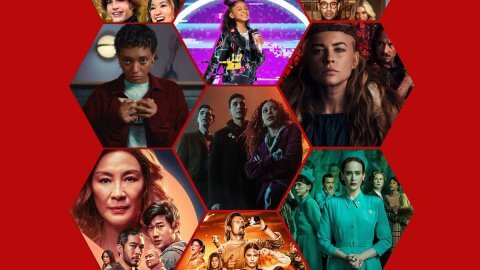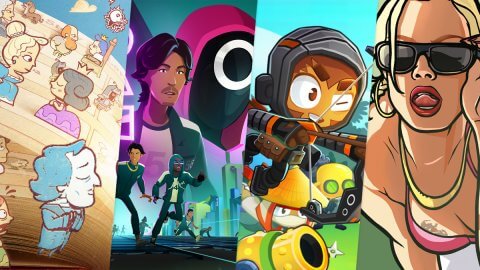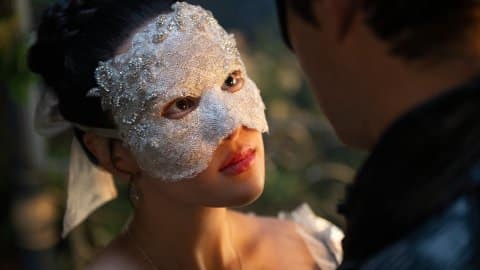
Netflix’s long-anticipated live-action adaptation of One Piece is just about to land on Netflix, and prior to its release, we had the pleasure of discussing the music and score of One Piece with the fantastic composers Sonya Belousova and Giona Ostinelli.
One Piece is a Netflix Original action-adventure series and the live-action adaptation of the manga of the same name by author and illustrator Eiichiro Oda. The world of One Piece takes place 22 years after the death of the most infamous pirate in history Gol D. Roger. On his deathbed, he inspired a brand new era of piracy, as rookie pirates dream of finding Roger’s coveted hoard of treasure. Rookie pirate Monkey D. Luffy sets sail in search of a pirate crew strong enough to share his dream of finding the One Piece and becoming the next King of the Pirates.
If you’re interested in the music of One Piece, the full soundtrack was released on August 31st, 2023.
Prior to working on One Piece Sonya and Giona collaborated as composers on eleven other projects together. This includes the Netflix Original series The Witcher, NBC’s The Thing About Pam, the movies Reprisal, Lying and Stealing, and more.
How did you first become involved in One Piece?
Giona: Well, first of all, we’re big fans of One Piece.
Sonya: We love One Piece. We watched the anime series, and when we learned about the project, we were so excited
and really wanted to be involved. So, funnily enough, it started with a video, because as soon as we
learned about the project, we decided to get creative. We shot a video in which we actually outlined
the whole concept behind the One Piece music universe that we would build and all the different themes
and instruments we would assign to each one of our characters.
Giona: And I believe this was December 2021?
Sonya: I think it was December 2021. I think you’re right. So it was so long ago by now, and that video got everybody really excited. And from there on, we were immediately on board. But funnily enough, all those concepts that we outlined in that video and the themes that we came up with, because we actually even wrote specific themes for the video and performed that theme on different instruments, representing our characters, all those concepts, now that we are done with the soundtrack, it’s about to come out. They all remained 100% true in the final product.
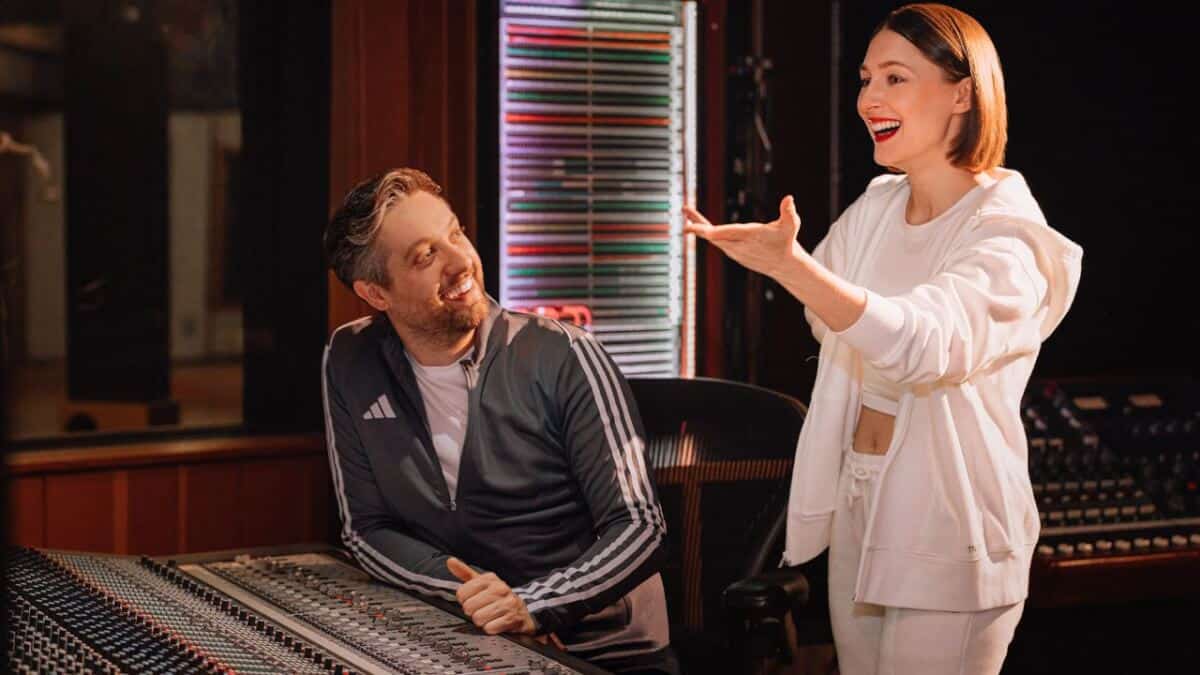
Pictured: Giona Ostinelli (Left) and Sonya Belousova (right) the composers of One Piece – Netflix
How would you describe your score for the series?
Sonya: The score for the live-action universe is very diverse stylistically because the whole universe is so diverse and our straw heads are so diverse within their roots and backgrounds and also their diverse and unique personalities and fighting styles and skill sets. So the whole concept of diversity was really something that was very paramount to us when building this music universe, and the score ranges stylistically from epic swashbuckling orchestra to songs featuring incredible artists such as Norwegian art-pop sensation Aurora, to hip hop featuring an amazing artist, Flawless Real Talk to rap to folk to big band jazz funk fusion.
Giona: And circus!
Sonya: Because, hey, there is a specific character who might require circus music.
Giona: Bluesy Ukulele!
Sonya: Bluesy Ukulele? No such genre existed before now. It does exist to anything and everything in between. Oh, and I’m forgetting the flamenco guitar featuring the incredible virtuoso guitarist, Marcine. So that diversity was absolutely paramount to us and we were so excited that we were given the opportunity to create such a stylistically diverse score and really embody all these different characters that we have in the series and all the different villains that we have in the series. And by being able to assign each one of them their specific instrument and theme.
Jacob: The fans will know when a villain like Don Kreig enters the scene, or Buggy the Clown, or Arlong?
Sonya: Exactly. All these villains are so iconic. Each of them deserves their own specific style and-
Giona: Not only their own theme but also their own specific instruments.
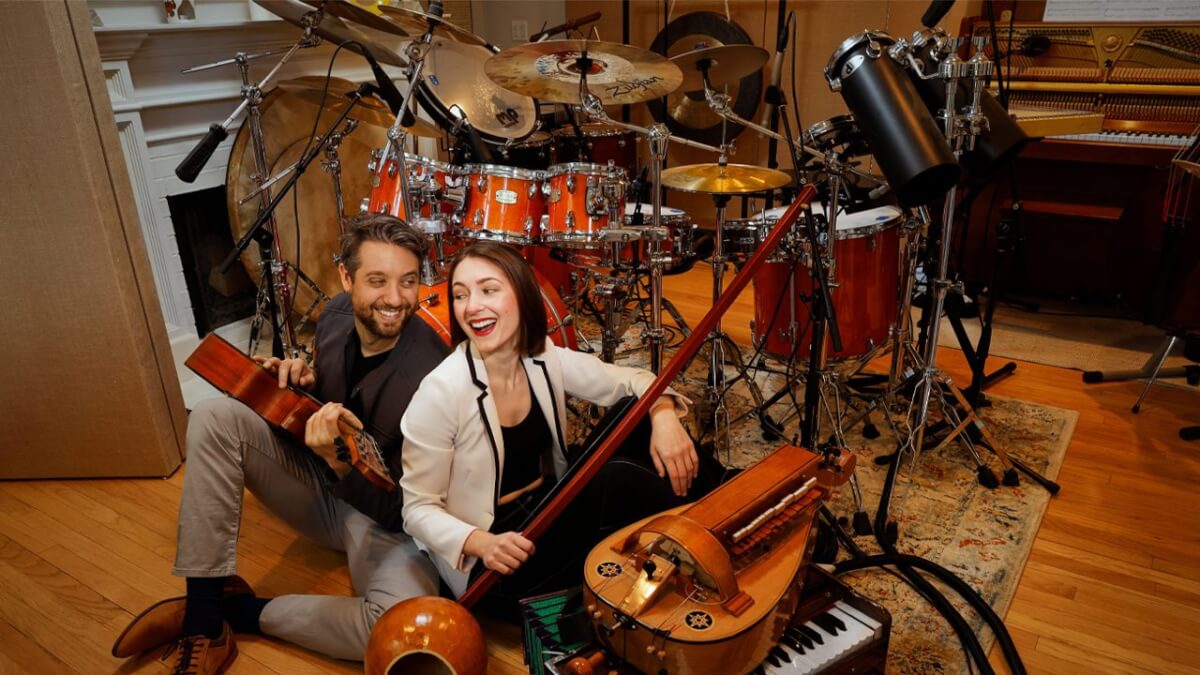
Pictured: Giona Ostinelli (Left) and Sonya Belousova (right) the composers of One Piece – Netflix
What can we expect from each theme of the Straw Hat Pirates?
Sonya: For example, we have Luffy, who is the captain of our Straw hats crew. And for Luffy, we’re using a couple of instruments. We’re mainly using a hurdy-gurdy because this is a pirate show. And what pirate show is without a hurdy-gurdy? Because for us, it’s that musical, iconic musical, Jolly Roger hurdy-gurdy. Then we’re also using a fiddle and we’re using banjo because from the very beginning, during our conversations with Matt [Ownens] and Steve [Maeda], we talked a lot about featuring live and organic instruments for our Straw Hats crew.
So that’s Luffy. Then for Nami, we feature her theme with a flute. And the cool thing about Nami and her theme, whereas, for example, when we wrote Toss a Coin to Your Witcher, we introduced the theme of that song at the beginning of the episode, and then the full song happened at the very end of the episode. Here with Nami, we actually get an opportunity to introduce the theme as soon as we meet Nami in episode one, and the theme shows up in a very playful, kind of quirky, determined manner. And then we give the opportunity to the audience to really experience the theme and really dive into this theme in all its different shapes and forms throughout the whole season before climaxing into its most powerful and lyrical song rendition at the very end of episode eight, brilliantly performed by the incredible artist Aurora. So that’s Nami and her theme really represents the emotional arc of the season.
Giona: Then we have Zoro!
Sonya: Zoro. I love Zoro. Zoro. The whole deal about Zoro is that he wants to be the greatest swordsman. And his fighting style, right? It’s all about three swords. He uses three different swords. So the idea behind it was, what if we give each one of his swords its own particular instrument? So we start with bansuri. And the reason why it’s bansuri.
Giona: Well bansuri is great because it’s a very long Indian flute, so it does look like a sword.
Sonya: It’s so long, it actually could pass for a sword. So, for example, when Giona plays the wrong chord, it’s like Zoro’s defending! So we have Bansuri, then we have a frame drum. Because its sound is so big and powerful, it’s perfect for one of
Zoro’s swords. Lastly, for his Ichimonji sword, because it’s a very special sword. It’s a sword with a lot of history, not only overall history but also specifically for Zoro with a lot of personal history connected to that sword. So for this sword, we’re using Duduk. Duduk being an Armenian instrument, it has a very kind of sacred quality about its sound, which was just perfect for that specific sword, especially given how rarely Zoro uses it only on very special occasions. So each time he uses it, that’s where we introduced the Duduk for that sword.
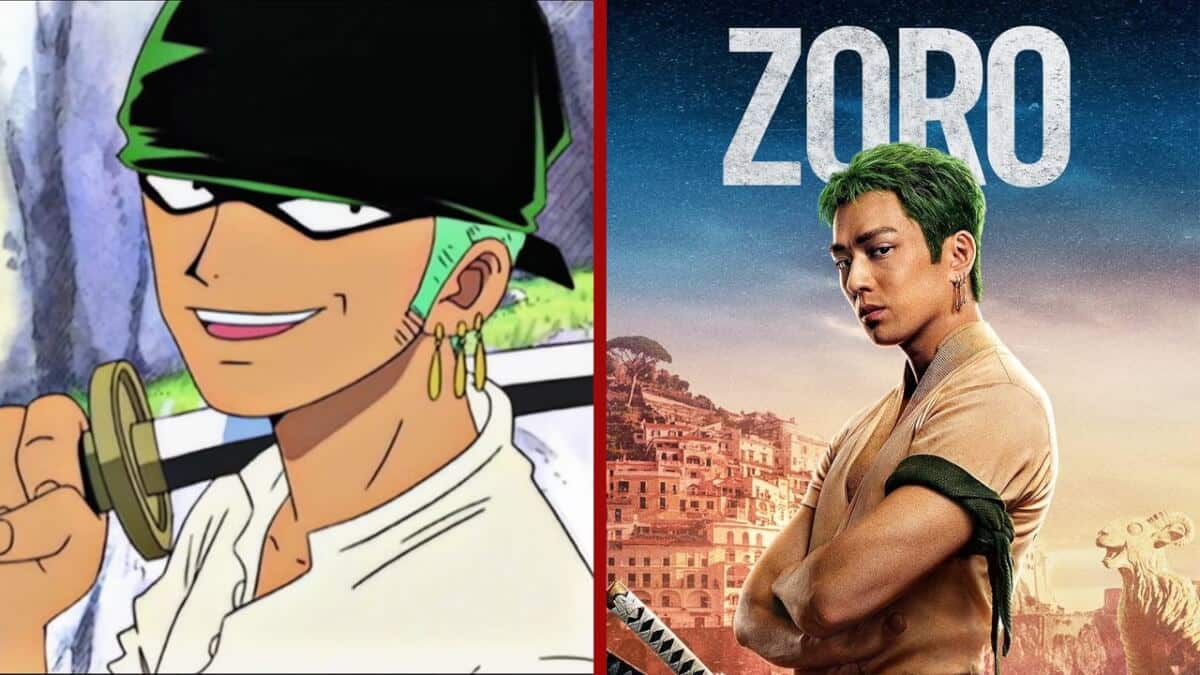
Pictured: Zoro (left) and Mackenyu as Zoro (right) – TOEI Animation / Tomorrow Studios
Giona: Then we have Usopp!
Sonya: Usopp! His dream is to become the biggest, the bravest pirate, just like his father, who he really looks up to. So, as of right now, he’s a little cowardly. He definitely lacks the inner confidence. So at this moment in the series, his sound is portrayed by a ukulele.
Giona: Because, you know, it’s a very small tiny instrument.
Sonya: We chose a ukulele because it kind of has a quirky vibe around it, which really fits Usopp really, really well. And then, throughout the course of this season and further on in the seasons, hopefully, we get there. This ukulele sound will grow as Usopp’s character grows, and as he gains his inner confidence from a small ukulele, it will go bigger, bigger, bigger, bigger. And eventually, we should get to a twelve-string guitar.
Giona: I think there’s going to be a certain point for a competition or contest of creating the biggest guitar for one piece because we’re going to run out of guitars.

Pictured- Usopp (left) and Jacob Romero as Usopp (right) – TOEI Animation / Tomorrow Studios
Sonya: And then sanji. We love Sanji. Sanji is such an amazing character. There is kind of a certain jazzy flavor about the character himself because he’s very sleek, he’s kind of elegant. He wears an elegant black suit, his hairpiece falls in one of his eyes. So there’s a certain sleeky jazzy feel about him. So we represent Sanji with the big band jazz funk fusion ensemble, which just fits his personality and his character so well.
Giona: And also because his fighting style is with the kicks. So we thought, what better representation of his
fighting style than doing a really cool, sick drum groove to match his fighting style.
Sonya: And that’s what we did.

Pictured: Sanji (left) and Taz Skylar as Sanji (right) – TOEI Animation / Tomorrow Studios
Giona: Yeah. And this idea of each character having their own theme and instrument is not just for the straw hats, but all the villains and we also have the marines, who have their own themes for specific marines.
Sonya: So overall, we’re featuring marine, military snares, and trumpets for the marine theme. And then depending on each specific marine that we get to encounter, we enhance on those layers and add additional layers or you know, there are villains like Buggy who know this incredible pirate. He’s an unhinged clown, but also a very powerful villain at the same time. So Buggy has a riff. It’s a musical riff.
Giona: First of all, he has circus music.
Sonya: Within the vibe of the circus music, but it has a riff, which is very important if you pay close attention. So you’re going to hear that riff every single time you meet Buggy. So you will know it and you will hear it. But since Buggy has chop-chop powers, well, what we actually did is we recorded the lyrics, chop, chop, chop to feature in that riff.
Giona: Yeah. And we did like, chop, chop, chop, chop, chop, chop! So every time there is Buggy chop, chop, you hear it in the music.
Sonya: And that encapsulated together with the circus vibe and flair, it’s just perfect for Buggy.
Giona: And we also did something else, like with Buggy, for example, when he’s about to show up, but we don’t
know yet who’s showing up, but the music, if you listen carefully, there is a chop chop chop chop chop.
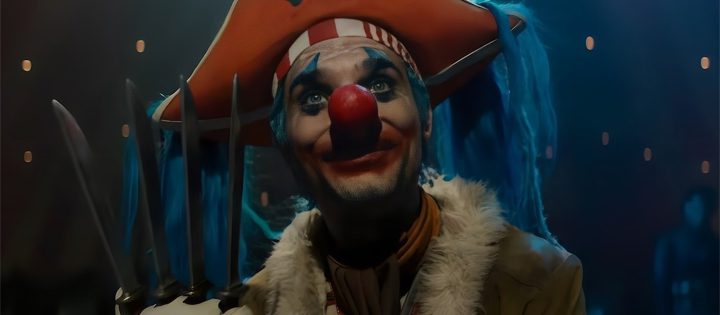
Pictured: Jeff Ward as Buggy the Clown – Tomorrow Studios
Sonya: Or take Kuro and the Black Cat pirates. For Korra and the Black Cat Pirates. We’re featuring the sounds of shrieking, dulcimers, and hurdy-gurdies. That sounds kind of like cats meowing. But we also recorded the sound of knives being sharpened because Kuro, his iconic look, features these great claws. And that’s just such an integral part of his look.
Giona: And we’re like, we need to have the sound of his claws in the music. Like, how can we have that?
Sonya: The funny part was recording that!
Giona: Yeah. Because sharpening knives and try not to cut the microphones in the meantime, or cut each other’s off in the meantime, it was a bit tricky. But then we figured it out and we succeeded. In fact, we’re still here alive. So, yeah, we succeeded.
Sonya: Then there is Arlong. Who is our biggest villain and the most important villain we see? And. With that said, he just looks so cool and so badass being such a fearsome villain. So he really needed that really cool theme. And what we’re doing with Arlong, his theme is beat-driven. So we have these really cool beats together with Arlong. So as soon as you see Arlong and his crew of fishmen, you get these really amazing, really cool meaty, greedy beats.

Picture: McKinley Belcher III as Arlong – Tomorrow Studios
Giona: Not only that, for example, Kaya has her own theme and her own instrument, which is an oboe that
plays when Usopp and Kaya are talking, so you have the ukulele and the oboe talking to each other.
Sonya: It’s very classy, very elegant. She lives in this huge mansion, so there is a lot of class about her and about her sound.
Giona: And hence the music had to reflect that. And then we have, for example, Zeff also with this super smoky trumpet.
Sonya: So, the bottom line is every single character in this show, because they’re all so incredibly unique and so incredibly stand out, every single character in this show has their own sound and their own instrument and their own theme.
From How Sarah Got Her Wings to One Piece you have collaborated as composers a total of twelve times (and credited on 25 projects together). What’s been the biggest benefit of composing as a duo?
Giona: It’s so much, fun.
Sonya: I think for us, the reason why it works so well is that we come from very different backgrounds because I started out as a concert pianist and I started playing piano when I was five, and then I went on to win every single international competition that was out there at that time. So for me, that classical background has always been around me, and the performance background, of course.
Giona: And for me, I started playing drums when I was five, then piano when I was nine, and then I started playing bands more like rock-pop bands, so I had more like a more rock-pop type of education, but still classical, but not obviously like Sonya.
Sonya: So we first worked together on a David Mammoth film and that score required a little bit of virtuosic piano because it was a very eclectic score. And Giona approached me if I wanted to collaborate with him on that score. And it wasn’t a fantastic experience writing that score together, because from just doing those piano scenes, we kind of did the whole score together. And
we very quickly realized that, given our different backgrounds, we never compete with each other, but we always complement each other really well. And then from there on, we’ve always been involved in each other’s projects and then at a certain point just started doing it all together because it’s just so much fun. And then for us also, recording is an integral essential part of our process because we have so many instruments in the studio, we literally don’t have any space anymore in the studio. we have everything and anything, so it’s full of instruments. So having the two of us here in the studio, it’s fantastic because we can split who can record which instrument and who can master which instrument. Because for example, with the Witcher we actually had to learn a lot of instruments. Well, I learned hurdy-gurdy, I had to learn how to play a Celtics harp, harmoniums a bunch of other instruments.
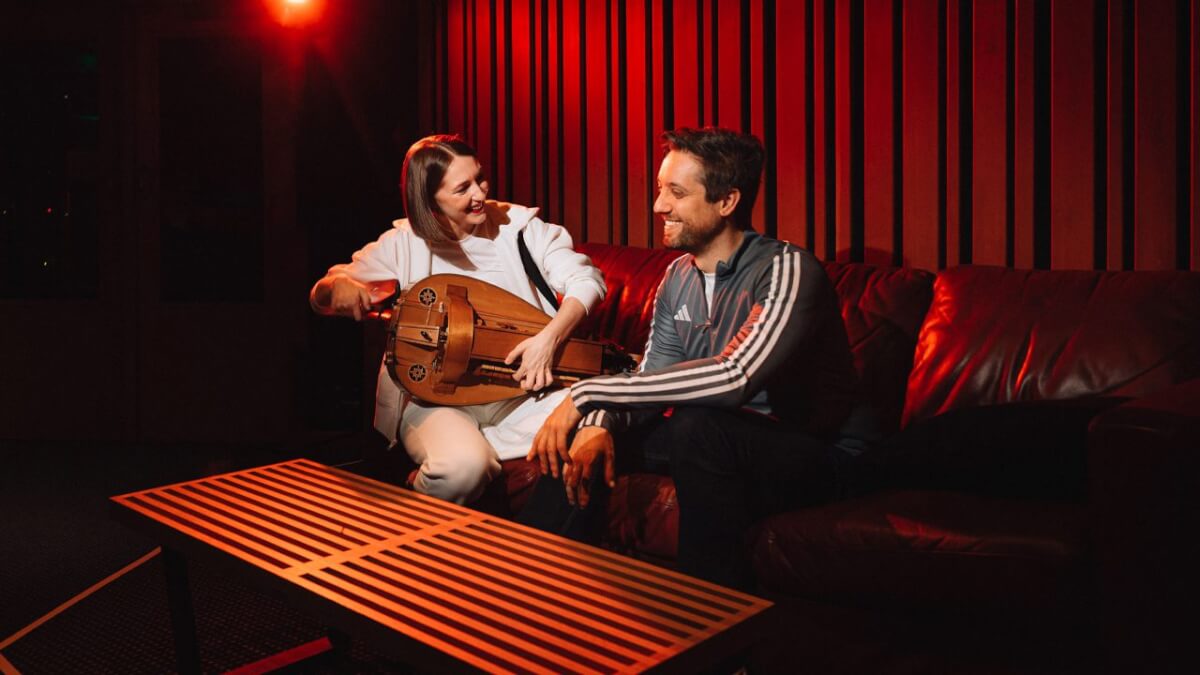
Pictured: Sonya Belousova (left) and Giona Ostinelli (right) the composers of One Piece – Netflix
Gonia: I was doing all the percussions, the drums, ethnic woodwinds, such as the Bansuri and Shakuhachi, oh, and dulcimers.
Sonia: So having the two of us here, it actually speeds up the process so much because we can assign
each other the instruments and it’s a lot of fun doing this process together.
Gonia: And also because working.Writing music. I think for a film or TV show, it’s about collaboration. You want to write something that brings emotion out of a scene. And maybe I perceive the scene in one way and maybe it’s not necessarily the correct way. And being the two of us, Sonia’s like, oh, what if we’re doing this way? It’s like, oh, this is a brilliant idea. And you get so much more emotions out of the scene and you’re like, this really makes you so close to the character and to what the scene means.
Sonya: And for us, this process has always been a very collaborative process because we collaborate with each other and we really love it, but we collaborate with artists, whether it’s with Joey Batey for Toss a Coin to Your Witcher, or in this case, with Aurora for My Sails are Set. Or we have our artist album coming out with Sony later this year where we’re going to feature an incredible lineup of amazing artists from Serj Tankian of System of a down to DL [Daniel Laskiewicz] of alternative rock band Bad Wolves. To Sophia James, who is a phenomenal singer and American Idol finalist a couple of seasons back to Tarja [Turunen], who is a Finnish soprano and a former Nightwish band leader, to Marcine. And speaking of Marcine, Marcine is a virtuoso guitar player and I just realized we never talked about Mihawk in the previous question, so I’m going to sneak it in here.
Mihawk as a character really embodies kind of a flamenco vibe about him because he has a long, know cape. He has that head, the sword with the diamonds. So as soon as we saw him as a character, we really wanted to bring in Marcine to collaborate with us on this project and to embody the sound of Mihawk. And just as Mihawk has so much elegance and class and ultimate precision in his swordsmanship, just as you know, with all his passion and ultimate technique, he was able to perfectly embody the sound of Mihawk. And we love calling his guitar style as an orchestra within one guitar, so that over-the-top approach, on one hand with ultimate precision, but on the other hand, with so much passion and fire, that was just perfect. So now, going back to the album, that’s where we also feature Marcine in one of the tracks. And that album comes out later this year, and it’s also all about collaboration because we get to collaborate with all these unique artists. So this collaboration process is just something that’s really at the core of what we do, and we love that.
Giona: Yeah. The weird part is she never let me play the piano together with her!
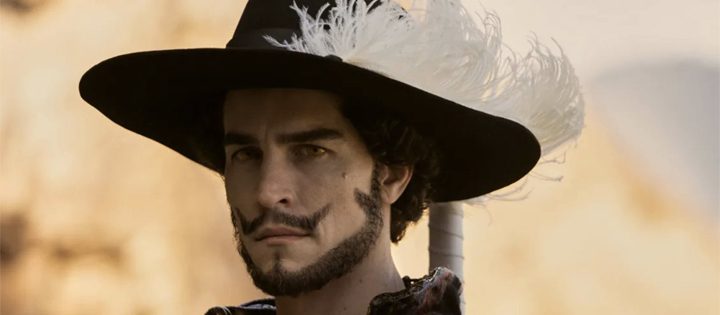
Picture: Steven John Ward as Mihawk – Tomorrow Studios
What is your biggest source of inspiration as to why you both wanted to become composers? What was the transition from musician to composer?
Sonya: For me, it’s never been about a transition. It’s always been both, because I started piano when I was five, and I started composition when I was eleven. So it’s always been both, really, because I was always fascinated by films, by storylines, by characters, and developing those characters. I was never so much into concert music, but I was always more about the type, of music that tells a story, and film music, just as a certain point became that and kind of embodied this interest together. And then also, there’s so much, again, going back to collaboration, there’s so much collaboration, at least for us, in this process, whether it’s working together or working with artists, it’s beautiful. And I always wanted to be a part of something like that. And now being able to be part of this and doing this, it’s incredible.
Giona: Yeah, for me I’ve always loved music and always loved movies and storytelling. And I think being a composer just in general and being able to write music for specific films and TV is such a great combination, such powerful storytelling. Music with stories has always been so powerful like there is with opera and then the same thing happened on screen.
So, since I was a kid, I always loved playing in bands. But when I was watching movies like Jurassic Park or Back to the Future, all those movies, it’s like, oh, my gosh. The power that you get, the emotion that you get from the music and seeing the images, whether it’s like DeLorean going back in time or seeing the big dinosaur, the T-Rex on screen accompanied by John William’s Amazing score. You get such goosebumps. And so I was like, I always wanted to do that.
Sonya: Goosebumps! Plus, for us, what we love doing is never repeating ourselves and we always love being engaged
in projects that require very unique and particular world-building. Which is why One Piece was really such a perfect project for us because after The Witcher, there was so much world-building in that project, and then when Toss a Coin blew up, and then suddenly one morning we woke up and it was number one on Billboard. So then One Piece was really the perfect continuation is that was another project that allowed us to really play around with this world-building and create a very unique and particular and diverse score. And this is something that we really love doing. So much fun.
Giona: And also composing lets you play around with so many different instruments and have so much fun and stay like a kid.
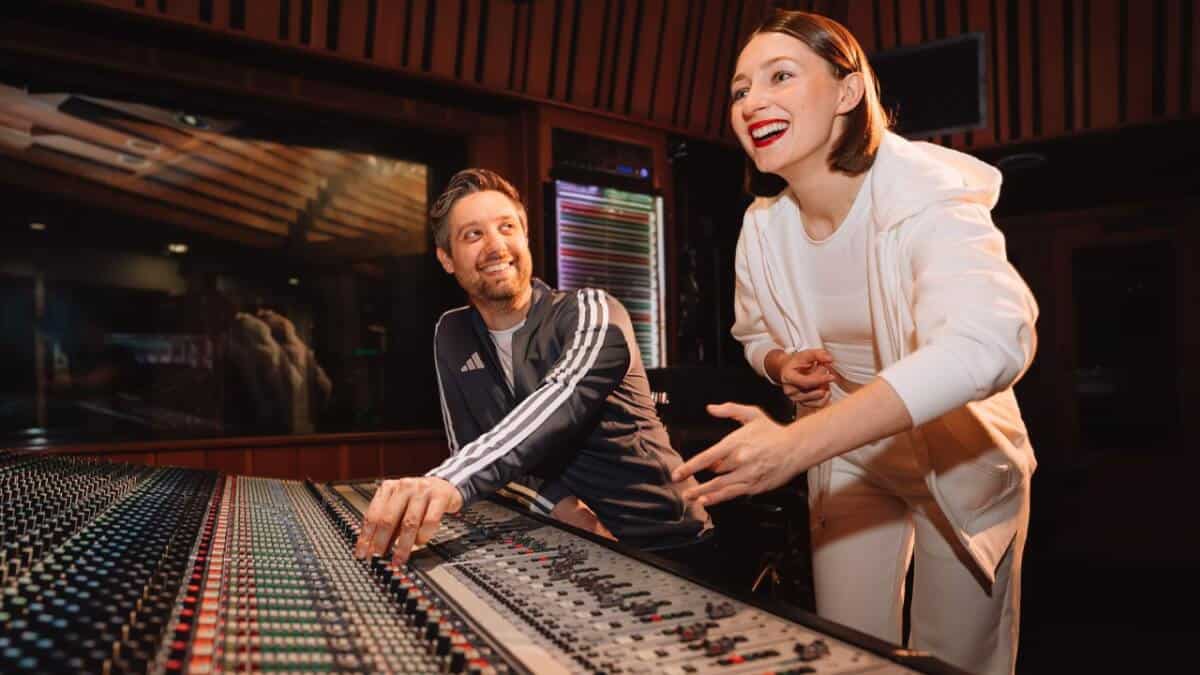
Pictured: Giona Ostinelli (Left) and Sonya Belousova (right) the composers of One Piece – Netflix
Jacob: I’m especially excited to see if the series does progress beyond season one, which we’re all hoping for. That the range
and versatility of all the different characters and villains. In particular, I’d love to see what you guys could do with Enel’s theme. Even the three admirals, or even Ace.
Giona: One Piece is like a giant Wagner open in a way because there are so many themes and motifs that are already in season one.
Sonya: That’s a really good comparison and also the way it was approached, I think in every single department, but especially for us, we never worked on it as Episodic TV. It was all episodes at the same time, so we were able to craft all the themes at the same time and really see through where we introduced those themes and how we developed those themes. So the comparison to a Wagner opera, as weird as it sounds, is actually a very accurate comparison because we have these eight episodes but in reality, the way this was approached is one massive blockbuster. So we have one massive blockbuster just like one massive Wagner opera. And there is a lot of motivic and thematic work that happens in the music throughout this giant blockbuster. So I’m just so excited for the audience to see it and to kind of follow through all the themes where we introduce them and how we develop them because there will be plenty of opportunities for tracking them down.
Overtaken is one of the most famous OST’s in One Piece, can fans expect to hear your take on them?
Giona: Let’s put it this way. It was of paramount importance to all of us, to the two of us, to Steve Maeda and Matt Owens the showrunners, to Netflix, to Tomorrow Studios, and of course, to ODA himself, that One Piece live-action has its own distinct identity, including its own distinct music identity. With that said, One Piece has been going on for so long. The anime started in 1999, I believe.
Sonya: By now there’s a generation of people who grew up with One Piece.
Giona: Yes, there are certain songs. Certain songs, certain themes motivic certain themes musically that I compare it to kind of like a James Bond. You cannot make James Bond without the iconic James Bond theme. Right?
Sonya: We couldn’t ignore the fact that there are those songs and themes that have become truly iconic within the One Piece global community over the years. So we do have several Easter eggs in the season. For those fans paying very close attention, they will find very subtle nods to some of the other iconic themes in some of the key scenes. That’s how I can phrase it right now.

Pictured: Giona Ostinelli (Left) and Sonya Belousova (right) the composers of One Piece – Netflix
Who is your favorite One Piece character?
Giona: Mihawk. Look everybody is fantastic. Every actor is fantastic and they’re so perfect and they fit the role perfectly. But every time we’re working on a Mihawk scene, it’s just there’s something about Mihawk that with me, I just love it.
Sonya: I also think for you, musically, Mihawk presents so many opportunities. And we do have a feature track with Marcine, with a Mihawk theme that’s such a fiery track, and I’m so excited for fans to hear it.
For me, I would probably say, well, my first answer will be all of them, but my second answer will be Nami because she’s amazing. She’s such a badass member of the Straw Hat crew. Like, On the one hand, you have her as a sharp thief and a navigator, but then on the other hand, there’s so much more to her character and there is a very dark past that she has been impacted with and a childhood trauma that she’s still getting over. So there is a lot to her character, there is a lot of depth, there are a lot of shades to her character. So musically, for me, that presented a fantastic opportunity to come up with a theme and then really develop these themes through so many variations and so many shades. Climaxing at the end of the season with the song rendition performed by Aurora. And then the whole factor of collaborating with Aurora, that was just so wonderful because Aurora is brilliant and she was the one artist to really embody Nami as a character. She brought in so much to her character, from those fragile emotional nuances to all the power that Nami as a character possesses. And then when you hear the song and you hear the last chorus, and when she gets into that powerful vocal chanting, that moment just takes my breath away every single time. So I would have to say, for me, it’s Nami because of the character development that we were also able to explore musically.
Giona: Yeah, and that makes sense because Nami being a thief. Now I completely understand why and how my chocolate always disappears!
The full soundtrack for One Piece will be released on August 31st, 2023.
Are you looking forward to the full release of One Piece and the soundtrack? Let us know in the comments below!

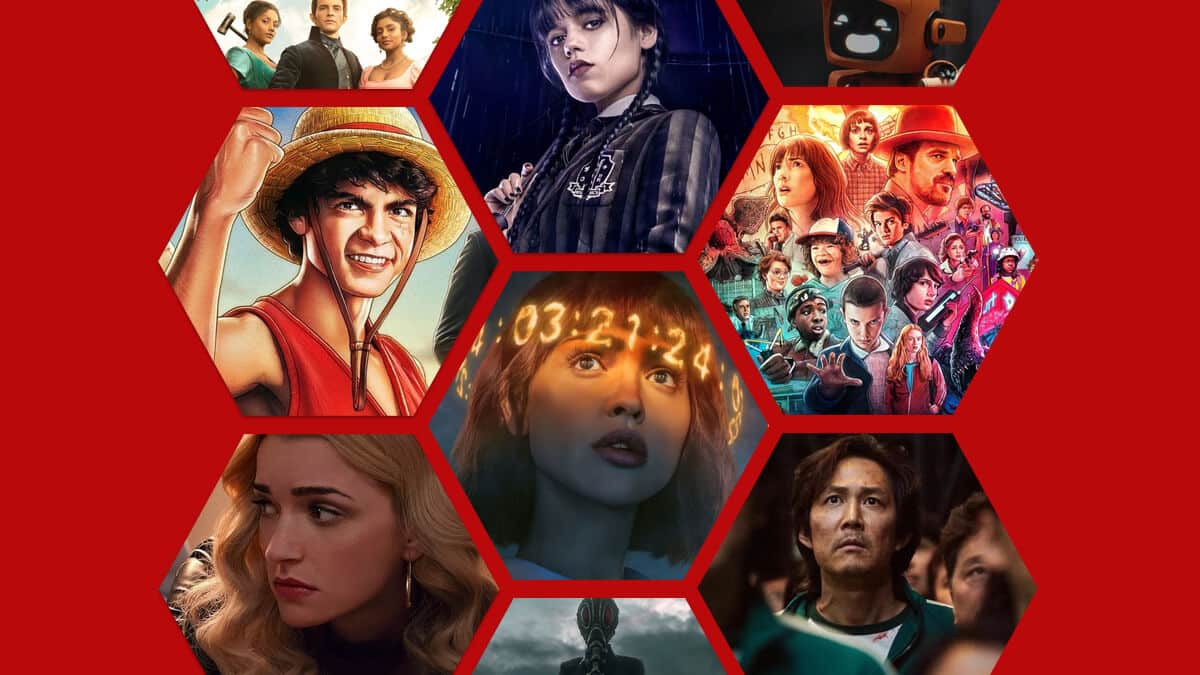
 Rating: TV-14
Rating: TV-14